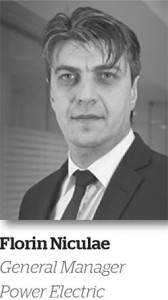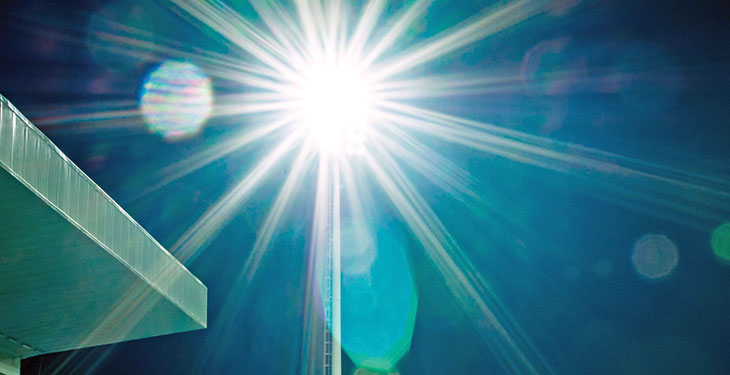Switching from conventional lighting fixtures to the energy efficient ones, based on LED technology, is done by a speed which took even the experts by surprise. Florin Niculae, General Manager of Power Electric explained for energynomics.ro how the company adjusted to support its customers to choose the most suitable lighting system in terms of energy efficiency and sustainability. In short: a broad portfolio of LED products, specialists regularly attending trainings provided by manufacturers and constant communication with partners.
Power Electric is active for over 20 years in electric materials distribution sector, specialised in lighting solutions. From this perspective and benefiting of this long term knowledge, can you please describe the main trends in the Romanian lighting market?
Following the need to optimize the energy related costs, manufacturers have sought technical solutions to reduce consumption and extend the life of the luminaires. This is what triggered the transition from conventional lighting to the one based on LED technology.

What are the most dynamic areas in terms of beneficiary: general consumption, professional area or others?
We speak of different trends. We observe an organic growth in end user demand, generated by increasing household income. Within this segment, traditional stores are recording declining sales, while large DIY retailers are gaining market share. Meanwhile, online sales are on an ascending direction, both in the B2C and B2B segment. However, this channel still represents a small percentage of total sales.
Regarding professional lighting project market, growth is steady, as companies are more and more focused on cost-effective energy solutions. Unfortunately, although in recent years office buildings where developed at a steady pace, in Bucharest, Timișoara, Cluj and Iași, we are surprised to find that some projects are handed over with outdated systems, based on fluorescent solutions. There are cases when the beneficiary requires updating the lighting system, which generates considerable extra costs and limitations of the existing system.
What are the main advantages of LED lighting solutions and what are the services provided by Power Electric?
The advantages of LED lighting solutions are cost effectiveness and reliability. In addition, LED products can be easily integrated into dynamic structures and superior technologies.
From this point of view, the situation is complex. When we are talking about costs, we are not only taking into consideration the energy consumption, although this is a very important factor, but we are looking at the maintenance component. Few companies in Romania today are taking this factor into account. For example, a fluorescent tube has the average lifetime of 10,000 hours, compared to 50,000 hours of a LED luminaire. This requires scheduling 4 additional maintenance operations for the classic lighting system, with extra costs related, including ones caused by business process interruption.
In terms of integration and control, there are advanced solutions such as intelligent systems for office buildings integrating lighting system with motion sensors and climate control system. Such a system enables companies that have employees with flexible working schedule and mobile workstations to manage space more effectively, for example, to close an entire floor when attendance is low and record a considerable reduction of total utilities consumption.
Power Electric provides turnkey projects for professional lighting solutions dedicated to office buildings, shopping centres and industrial parks and also projects for updating existing systems.
How do you currently evaluate the process of transfer from conventional lighting fixtures to the energy efficient lighting systems based on LED technology, in Romania ? How is Power Electric contributing to this transfer?
This transition was made at a much higher rate than was estimated. Nobody was expecting such rapid growth and many manufacturers and partners, including Power Electric, were not ready for the change. But we have adapted quickly. In addition to building a broad portfolio of products based on LED technology, our specialists are regularly attending training provided by manufacturers. At our turn, we are maintaining a close relationship to our customers and constantly communicate, to support them in choosing the suitable lighting system in terms of energy efficiency and sustainability, in order to control long-term costs.
What is the decisive factor for most of your customers: price, quality, technology or energy efficiency?
Fortunately, our client portfolio is special. The decision to buy is most usually made on quality, efficiency and technology. Unfortunately, the budget pressure for lighting systems made its mark on the overall market: 65% of purchases made are based only on price. In such circumstances it is difficult, if not impossible, to propose a solution based on a brand recognized for quality and reliability, such as those in our portfolio. And this reality is visible in regional analyses for Central and Eastern Europe: in Romania the import of lighting products from China has increased, from 21.8 million EUR in 2011 to 48.3 million EUR in 2015, when it represented about 32 % of total imports of this kind. In the period 2014 – 2015 the increase in imports from China was 29.3%.
In which way lighting solutions can be customized according to the needs of a particular client? Please outline a typical case study, with workflow and final benefits?
Basically, there are no limitations in terms of customizing special projects. Customer requirements come first, and then we present our recommendations. We strive to exceed expectations both in terms of cost-effectiveness and in terms of visual impact.
A project which we are proud of is Viitorul Constanța Stadium, executed for Gheorghe Hagi Football Academy. Power Electric has provided all necessary services: the lighting design, coordination and supervision of the installation work, commissioning and reception.
The main requirement of the beneficiary has been to increase the level of lighting in the stadium, so as to meet the requirements of the Romanian Football Federation in order to obtain the license for stadium and approval for playing in League 1. It was necessary to improve light quality for playing surfaces and adjacent spaces to allow the TV broadcast of the events held at the stadium. At the same time, it was important the optimization of initial investment cost and also of long-term costs arising from maintenance and operation of the lighting system.
Power Electric team proposed for this project a modern solution, reliable and energy efficient, composed of spotlights and projectors with different distribution angles, which allowed to reach the requirement of minimum 1200 lux, using only 96 projectors.
What is the biggest challenge you are facing now?
The entire lighting sector is facing an acute shortage of specialists because the universities in Romania do not have educational programs covering skills needed for the position internationally known as “Lighting Designer”. There are separate disciplines: Electric Installations (Technical University of Civil Engineering), Telecommunications (Polytechnic University) and Lighting for Buildings (University of Architecture and Urbanism), which should be integrated .
At the moment it is necessary to form our own specialists using specific courses covering various topics, from lighting and electrical network to IT and design, and this requires considerable effort, costs and time.
—————————————-
The full version of this article can be read in printed edition of energynomics.ro Magazine, issued in September 2016.
In order to receive the next issue (December 2016) of energynomics.ro Magazine, we encourage you to write us at office [at] energynomics.ro to include you in our distribution list.
